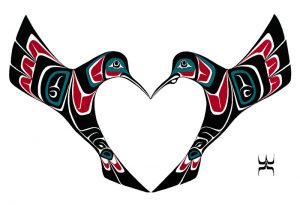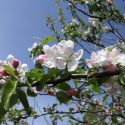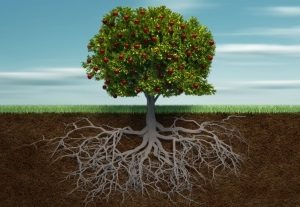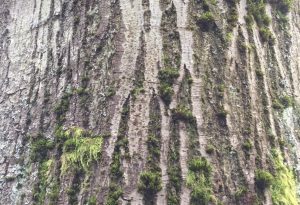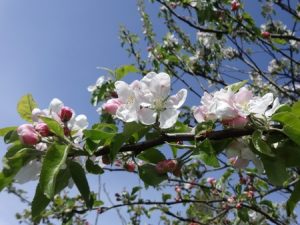How Evil Came Into The World
Lesson 1.3 – Assignment 1:5
This is my story about how evil came into the world. I invite you to listen to to this audio recording of me telling my story while you read the words.
click here for mobile access to audio of How Evil Came Into the World
I have a story to tell you…
A long, long time ago the world had only one little house. This small house had two rooms.
One room faced east. It had a big window overlooking a lush valley where the sun always shined.
The other room faced west. It had a small door that opened out onto a balcony which overlooked a vast ocean covered by swirling grey mist.
Birds could be seen chasing each other in the clear blue sky above the valley. Zigzagging down the sides of the vale were many different trees, some yellow, some green, and a few were pink.
Beneath the tumultuous haze, the surf crashed with a steady beat, and each swell called out as it hit the shore “there’s more” … “there’s more” … “there’s more” … Seagulls dive bombed into the waves, and came up flapping their wings as they soared into the roiling clouds.
Since time began a girl and a boy lived in the house.
The girl spent hours looking out her window. In the early morning, just after the sun had risen, and was shining down upon the valley, she would laugh as she watched elk, foxes, and moose washing their faces in the river.
The boy studied the vast open space beyond his balcony. Every evening, as the sun was setting, a golden path appeared across the surface of the sea, and called out to him. Depending on the mist, the path might be clear and straight, or hidden and barely seen, but he always knew it was there.
They both knew what they knew.
But they didn’t know what they didn’t know.
They knew they had each other.
They knew every inch of the valley including the names of all the animals and all the birds who came to play.
They knew all the secrets the trees held, and the mystery of day and night.
But they didn’t know what was beyond the ocean.
They didn’t know what was outside their valley.
The girl loved watching the little river, which was not much bigger than a stream, as it meandered between granite rocks and a rainbow of wildflowers. She couldn’t understand why the boy wanted to know what was out beyond the sea.
The boy’s yearning for something different grew stronger and more desperate. He wasn’t satisfied with frolicking birds, or playing with the flora or fauna within their valley. He desired to see where the golden path lead. He needed to know what was hidden at the ends of the world.
One gloomy, rainy day when he was wishing for something, but he didn’t know what, he saw a curious thing. A new thing, something he had never seen before. He saw an object floating and shimmering in the waves.
For the first time in a long time, he smiled and laughed. He grabbed the girl’s hand and pulled her down the stairs. He dragged her towards the end of the beach, as he pointed with his other hand towards the new and the unknown.
His heart pounded as he reached down to pick up the bottle, but the girl warned him not to touch it. She told him it didn’t belong. She tried to pick it up and throw it into the ocean, so it could return to where it had come, but he pushed her hand away.
He grabbed the bottle and lifted it. He examined the strange and exotic object. Shaking the bottle he could hear liquid splashing around. He uncorked it, and peered inside. The most wonderful aroma wafted out. It smelled like lavender and chocolate. For just a second a different smell escaped – a sour smell of rot and decay. But it quickly disappeared, and the luscious aroma returned.
The elixir smelled intoxicating. He lifted the bottle to his lips, and took a long drink. Twitching and moaning he fell to the ground. His legs flailed and his fists beat the sand. He had a vision. In it, a man came to him and said, “I have a story to tell you”. The man told him about a world full of broken concrete, and crying children. The boy could see himself standing in a place filled with blood and body parts strewn around. He even saw his sweet companion lying still and broken with vacant eyes.
The boy gasped, and sat up. Looking first one direction and then another, he breathed out when he saw that the man was gone. He found himself back on the beach. The girl sat beside him, holding his hand. When he looked at her the terrible vision returned, and all he saw were her dead eyes. The vision receded when she hugged him, but it didn’t completely disappear. For the first time in his life he was afraid.
He wanted to put the liquid back into the bottle. He wanted to unknow all that death and destruction. He wanted to unsee all those horrible images. But it was too late. He now knew. He knew those evil things were out there, and he knew those heinous things were inside him.
Crying, the girl shook his shoulder, and begged him to tell her what had happened. He did. He told her everything he heard, saw, and felt. Now she knew too.
Once a story is experienced, it becomes a part of you.
Once a story is told, it cannot be unsaid, because now it has been released into the world.
Be careful of the stories you tell yourself and others. But most especially, be careful of what stories you listen to, because they create your world.
My experience of what I discovered about story telling:
In this assignment we were to read Thomas King’s version of Leslie Silko’s story, from her book Ceremony; it is a story about how evil first came into the world (King 9 -10). I found a WordPress website, The Abysmal: Nothing’s Better, which discusses Thomas King‘s The Truth About Stories : a Native Narrative from the Massey Lecture Series, and includes links to the lectures. In this website, there is a reprint of Leslie Silko’s story from Ceremony, in its entirety.
I memorized, and told my story to several of my friends, and all of my family. I found that each time I told my story, it changed in subtle ways from the previous version, yet the overall story and meaning remained the same. Often I found it difficult to tell my story from beginning to end without interruption. I received feedback from everyone I told my story to, and I found that different people had different reactions, but almost everyone felt the story had a moral to it. Several people felt it was an archetypal story, similar in many ways to Adam and Eve combined with Pandora’s Box.
For myself I found the experience of telling the story very different from having my audience read the story. When you hand your story off, the person takes it and reads it. This makes it a solitary event. First you are alone when you write it, and then they are alone when they read. However, when you tell someone your story, it becomes a social event, and everyone in the group becomes a participant and is connected through the story. The other factor that makes telling a story to an audience very different from having them read it, is the very act of storytelling. When the words are read, they are as they are written. However, when the words are spoken, a whole slew of additional factors influence the meaning and the experience. Even something as simple as what words are emphasized can drastically change the meaning. This link from Factinator gives examples of how the meaning of a sentence can drastically change depending on where the emphasis or where the punctuation is placed. Through the process of writing this story, and reciting it for an audience, I came to realize the importance of language itself. It is through language that each of us creates our reality, and as a result, it really is true that the stories we hear, even if they are the stories we tell ourselves, create our world.
Works cited:
Khawaja, Zainab. “‘I Never Said She Stole My Money’ Has 7 Different Meanings”. Factinator. 28 Feb 2014. Web. 30 May 2016.
King, Thomas. The Truth About Stories: A Native Narrative. CBC Massey Lectures. 2003. Lecture.
—The Truth About Stories: A Native Narrative. Toronto: House of Anansi Press, 2003. Print.
Marloeshi. Message in a Bottle. n.d. Digital Image. Deviant Art. Web. 26 May 2016
The Abysmal: Nothing’s Better. “The Truth About Stories”. WordPress. 02 July 2012. Web. 30 May 2016.
Weebly. “Musical and Literary Archetypes” Weebly. n.d. Web 30 May 2016.




